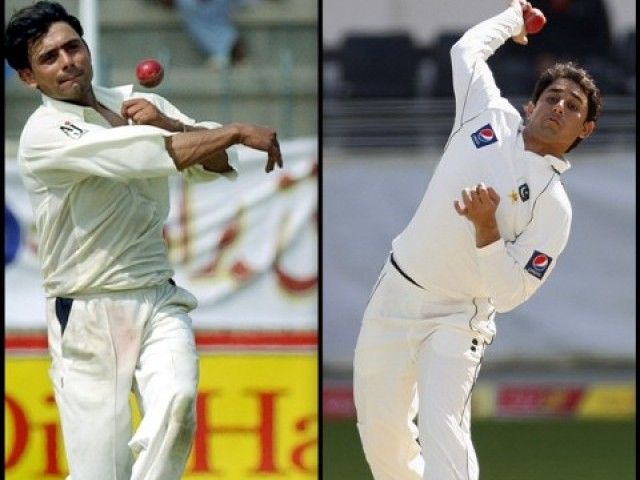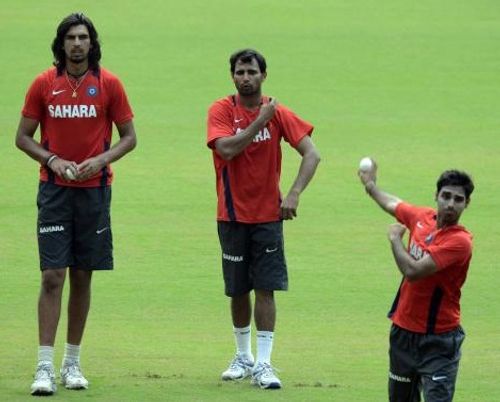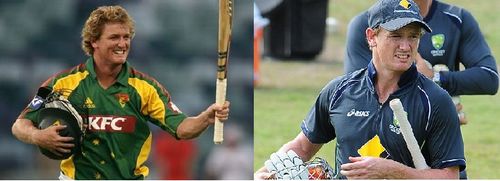
Saqlain vs Saeed - The curse of late bloomers

Saqlain and Ajmal – The inventor of doosra and one of its most effective users.
Howard Cosell, a legendary sports journalist and broadcaster from the ‘50s, once said – “Sports is human life in microcosm”. I couldn’t agree more with this beautiful statement that sums up the meaning of sports in human life so succinctly. Be it the adrenaline rush it offers to the recreation-seekers or the satiating calm it brings onto an ever-thirsty aspirer, the irresistible charm of sports has ensnared us all at least once in our lives. But still, only a small fraction of us end up choosing sport as our professional career and an even tinier fraction go on to become good at that. Although being in the prime condition of one’s life is the most patent prerequisite entailed in the job description, it is that uneasy thought – of the consequences in the event of a failure – always looming at the back of one’s mind which makes professional sport a high-risk career. And such a gamble only a young spirit, full of unbridled passion, uninhibited by any obligations can make. So, we can safely label professional sport as a “young man’s game”. As a sport, cricket is no exception in this matter.
The prime of an average cricketer’s professional career, almost invariably, starts in his early 20s and ends in his mid 30s. But it’s not your average cricketer that I want to talk about. It is the anomalies that intrigued me, especially those at the start of a career. Anomaly might be a bad choice of a word to describe them. Anomaly is usually associated with something bad or unpleasant. No matter what size and shape they come in, the one thing these exceptions have in common is that they are always a treat to watch. Whether it is genius that blossoms early, like Saqlain Mushtaq, or a talent that is attained through gritted teeth and persistence, like Saeed Ajmal, these exceptions rarely fail to capture our attention. But what makes them special? What is the cause of this exception? And, what is it that makes them the entertainers they usually are?

Young debutants not so uncommon anymore
Although still infrequent, it is not really a rare sight these days to see a teenager debut in the international team. With all the big money that entered into the mainstream of international cricket over the past decade, there has been a drastic change in both the reach and appeal of professional cricket. And with all the format changes, like the introduction of T20, opportunities in professional cricket proliferated in the recent times. It might only be a matter of time before teenage debutants become the norm rather than the exception. Whether in their genes or from the conditions they grow up, some develop an exceptional feel for the game. I do not mean to say that they are born with the knowledge of the cover-drives and the doosras. The difference between them and an average cricketer can be compared to that between a sponge and a brick. Both of them can absorb water, but the extent to which they can and the rate at which they can is what really separates them. Due to their extraordinary intuition and unlimited passion for the game, it is unusual for players in this category not to debut in their teens.
And then there are the late bloomers. Since domestic cricket doesn’t pay off as handsomely as its international counterpart, most of the players who get passed over a few times for chance in the international side retire and start their career in other avenues. Those that stay back, with their enormous passion for the game and unrelenting spirit, gradually transform their game; constantly outperforming themselves, pushing their limits, until the perfection they attained can no longer be passed over for. Perhaps they might not be as blessed in the intuition department, but through sheer hard work and tenacity, they transform into something perfect; the way coal evolves into diamond. It is, thus, no surprise that, the one thing all the late bloomers like, Saeed Ajmal, George Bailey, David Hussey, Faf du Plessis, James Tredwell, Johnathon Trott have in common is their never-give-up attitude, other than their exceptional technique.

How different would it have been if Bailey was given an opportunity earlier in his career?
There is one decisive contrast between these two categories of aberrations – maturity. Far too often in the recent times have we seen a teenager debut, oozing promise, but failing to perform at a bigger stage, disappear from the radar, come back a few years later and perform in his early 20s. The late bloomers usually take the world in a flurry and their rise to the apex is meteoric, but there is a catch. With a delayed start, their careers are bound to be shorter. This leads one to contemplate a very tempting idea – “What if Ajmal had the opportunity to play for two extra years?” or “Bailey” or “Tredwell” or any of the other cricketers who had to wait patiently for over 10 long years before a chance in their national team. But then, if they did indeed have an earlier chance, would it have made them as special as they are now? Saeed Ajmal and Saqlain Mushtaq are nearly of the same age and debuted in domestic cricket a year apart. However, Ajmal debuted in the international side 13 years later, 4 years after Saqlain retired, who was by then, widely considered as a legend and hailed as the genius who invented the doosra. So, I ask – What if Saqlain Mushtaq was passed over for Saeed Ajmal early in his career, would we have a different inventor of doosra today? Or would the world have never seen it?